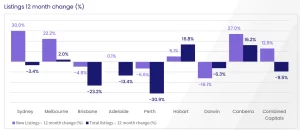The Sunshine Coast Property Clock: Trends and Projections
Weekly Real Estate Market Update with Leigh Martinuzzi
Take a look at this week’s property clock, courtesy of Matusik. It’s a powerful representation of past upswings and downswings in the property market, combined with current price and sales transaction trends. This chart offers us a panoramic view of where different property markets across the country are situated. One notable observation is that the Sunshine Coast is still in a declining market, with no signs of hitting the bottom just yet. In this blog, we’ll dive into current property market trends both nationally and locally, allowing us to better understand the dynamics at play for the remainder of 2023 and possibly into 2024.

The Reserve Bank of Australia (RBA) has maintained the cash rate for the past few months. While this stability has provided a boost in confidence for both buyers and sellers, an air of uncertainty still lingers. Inflation remains above target, and some economists anticipate a future cash rate increase, potentially before Christmas. The RBA may have paused to assess the full impact of the rapid interest rate hikes implemented over the past year, as evident in the slowing of output growth.
Australia’s capital cities have experienced combined growth of 8% this year, largely driven by substantial price increases in Sydney (10.4% year to date) and Brisbane (9.5% year to date). Brisbane’s prices may also be somewhat inflated due to the growing interest in its property market, thanks to the forthcoming 2032 Olympics. The driving force behind this continued growth is the persistent imbalance between demand and supply. The short-term outlook for supply growth doesn’t seem promising.

On the Sunshine Coast, we’re observing more conservative trends. According to CoreLogic, prices have dipped by 0.4% over the past 12 months. Nevertheless, it’s important to remember that prices on the Coast skyrocketed during the pandemic boom, reaching heights of 60% and more. While the pace of price growth has slowed, property values remain stable. Supply issues are also evident here, with a shortage of properties for sale and robust demand preventing a sharper decline in prices.
Rental prices are on the rise, even though rental turnaround times are also slowing down. Investors are feeling the pinch, as increased rents have been offset by higher repayments. Consequently, we’ve seen a notable number of investor properties hitting the market due to declining returns on investment. Investors may be facing interest rates as high as 9%, while first-home buyers are currently looking at rates around 6%. The promising news is that most economists and the major banks anticipate a cash rate reduction in the coming year and into 2025.
As we enter the spring selling season, more properties are making their way to the market, boosting seller confidence. However, the volume of new listings still falls below historical norms. The trend of high prices is encouraging sellers to list their properties for sale. On the Sunshine Coast, a similar pattern is observed, but sellers must remain flexible with their price expectations, as cautious buyers are wary of overpaying. Recently, a broker mentioned a slowdown in new loan requests.

The outlook for the remainder of 2023 appears positive for both sellers and buyers. We anticipate more sellers listing their homes in the next month or two before the market slows for the festive season in December and January. Spring presents an opportune time for sellers to showcase their homes before Christmas. While prices are expected to remain resilient as we head into 2024, substantial price growth may not be on the horizon.

